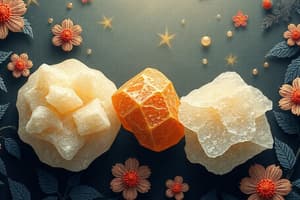Podcast
Questions and Answers
What type of glycosidic linkage is found in the linear polymer of β-D-fructose units?
What type of glycosidic linkage is found in the linear polymer of β-D-fructose units?
- β(2,1) linkage (correct)
- β-1,4 glycosidic linkage
- α-1,4 glycosidic linkage
- α(2,1) linkage
Human digestion can fully metabolize the polysaccharides formed from β-glucose units.
Human digestion can fully metabolize the polysaccharides formed from β-glucose units.
False (B)
What is a primary use of dietary fibers in the human body?
What is a primary use of dietary fibers in the human body?
preventing constipation
Incomplete hydrolysis of dietary fibers results in the production of ______.
Incomplete hydrolysis of dietary fibers results in the production of ______.
Match the following polysaccharides/disaccharides with their properties or uses:
Match the following polysaccharides/disaccharides with their properties or uses:
Which of the following enzymes can hydrolyze sucrose?
Which of the following enzymes can hydrolyze sucrose?
Sucrose is a reducing sugar.
Sucrose is a reducing sugar.
What two monosaccharides make up sucrose?
What two monosaccharides make up sucrose?
Raffinose is a trisaccharide made of galactose, glucose, and ______.
Raffinose is a trisaccharide made of galactose, glucose, and ______.
Which polysaccharide is primarily made up of glucose units?
Which polysaccharide is primarily made up of glucose units?
Match the following polysaccharides to their descriptions:
Match the following polysaccharides to their descriptions:
Heteropolysaccharides are formed from two or more different monosaccharides.
Heteropolysaccharides are formed from two or more different monosaccharides.
What is the primary result of hydrolyzing cellulose?
What is the primary result of hydrolyzing cellulose?
What is produced when the aldehyde group of glucose is oxidized with a mild oxidizing agent?
What is produced when the aldehyde group of glucose is oxidized with a mild oxidizing agent?
Galacturonic acid is derived from glucose through the oxidation of the last -CH2OH group.
Galacturonic acid is derived from glucose through the oxidation of the last -CH2OH group.
What type of linkage connects the glucose units in maltose?
What type of linkage connects the glucose units in maltose?
The oxidation of both the aldehyde group and the last -CH2OH group results in the formation of __________ acid.
The oxidation of both the aldehyde group and the last -CH2OH group results in the formation of __________ acid.
Match the following sugar acids with their correct source or oxidation type:
Match the following sugar acids with their correct source or oxidation type:
Which of the following is NOT a reducing disaccharide?
Which of the following is NOT a reducing disaccharide?
Cellobiose consists of two α-glucose units linked together.
Cellobiose consists of two α-glucose units linked together.
What is a characteristic feature of reducing sugars?
What is a characteristic feature of reducing sugars?
Flashcards are hidden until you start studying
Study Notes
Sugars
- Sucrose is naturally dextro-rotatory but hydrolyzes to a levo-rotatory mixture of glucose and fructose.
- Sucrose is also known as invert sugar.
- Sucrose is formed from α-glucose and β-fructose by α,1-β,2 glycosidic linkage.
- Sucrose occurs in most fruits and vegetables.
Oligosaccharides
- Trisaccharides contain 3 monosaccharide units.
- Tetrasaccharides contain 4 monosaccharide units.
- Raffinose is a trisaccharide composed of galactose, glucose, and fructose.
- Stachyose is a tetrasaccharide composed of 2 galactose molecules, glucose, and fructose.
Polysaccharides
- Polysaccharides are polymers of more than 10 monosaccharide residues united by glycosidic linkages.
- Homopolysaccharides (homogenous) yield the same type of monosaccharide units on hydrolysis.
- Heteropolysaccharides (heterogenous) are made of two or more different monosaccharides.
Homogenous Polysaccharides
- Pentosans: Yield pentose units on hydrolysis.
- Found mainly in vegetable gums like arabinose.
- Hexosans
- Glucosan: Yield only glucose units on hydrolysis.
- Examples include starch, dextrins, cellulose.
- Starch and dextrins are storage forms found in tubers and roots.
- Cellulose is a linear polymer of β-glucose units linked by β-1,4 glycosidic linkages.
- Cellulose cannot be digested by humans.
- Fructosan: Yield only fructose units on hydrolysis.
- Example is Inulin.
- Inulin is a linear polymer of β-D-fructose units linked by β(2,1) linkages.
- Inulin cannot be digested by humans.
- Dextran
- Found in cherry gum.
- Glucosan: Yield only glucose units on hydrolysis.
- Medical uses:
- Dextran: Used as a blood plasma expander.
- Inulin: Used as a dietary fiber and to measure Glomerular filtration rate (GFR).
Derivatives of Monosaccharides
- Sugar Acids:
- Aldonic Acids: Have a COOH group formed by oxidizing the aldehyde group.
- Examples are gluconic acid and glyceric acid.
- L-ascorbic acid (vitamin C) is an aldonic acid.
- Uronic Acids: COOH group formed by oxidizing the last -CH2OH group.
- Examples are glucuronic acid (from glucose) and galacturonic acid (from galactose).
- Aldaric Acids: Have COOH groups formed by oxidizing both the aldehyde group and the last -CH2OH group.
- Examples are glucaric (or saccharic) acid from glucose and mucic acid from galactose.
- Aldonic Acids: Have a COOH group formed by oxidizing the aldehyde group.
Disaccharides
- Reducing Disaccharides: Contain a free aldehyde group, forming an osazone.
- Maltose: Composed of two α-glucose units linked by α,1-4 glycosidic linkage.
- Lactose: Composed of glucose and β-galactose linked by β,1-4 glycosidic linkage.
- Cellobiose: Composed of two β-glucose units linked by β,1-4 glycosidic linkage, found in cellulose.
- Non-reducing Disaccharides: Do not have a free aldehyde group.
- Sucrose:
- It results from the careful hydrolysis of cellulose.
- Not fermented by yeast.
- Sucrose:
- Disaccharides further classified into two types:
- Reducing disaccharides
- non-reducing disaccharides.
- Reducing disaccharides contain free aldehyde groups and forms osazones.
- Non-reducing disaccharides do not contain free aldehyde groups, and not capable of forming osazones.
Studying That Suits You
Use AI to generate personalized quizzes and flashcards to suit your learning preferences.




